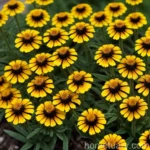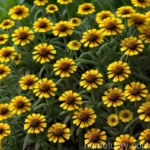Plant Scientist’s Guide to Sneezeweed (Helenium ‘Balsalulow’ SALUD YELLOW)
Sneezeweed, scientifically known as Helenium ‘Balsalulow’ SALUD YELLOW, is a stunning perennial known for its bright yellow daisy-like flowers. As a plant scientist, I am thrilled to delve into the fascinating world of this beautiful plant. In this comprehensive guide, I will cover various aspects of sneezeweed, including its culture, uses, care requirements, and much more. Whether you are a gardening enthusiast, a landscape designer, or simply intrigued by the world of plants, this guide will provide valuable insights into the world of sneezeweed.
What is Sneezeweed?
Sneezeweed, or Helenium ‘Balsalulow’ SALUD YELLOW, belongs to the Asteraceae family and is native to North America. It is a clump-forming perennial that typically blooms from mid to late summer, adding vibrant color to gardens and landscapes. The plant’s common name, “sneezeweed,” may be misleading, as the plant does not cause sneezing. The name is believed to have originated from the historic use of the plant’s dried leaves in making snuff, a form of powdered tobacco that was inhaled and induced sneezing. However, it is important to note that sneezeweed is not used for this purpose in modern times and should not be ingested due to its potential toxicity.
Key Takeaways – Sneezeweed (Helenium ‘Balsalulow’ SALUD YELLOW)
Before we delve into the detailed aspects of sneezeweed, let’s take a quick look at some key takeaways about this captivating plant.
- Scientific Name: Helenium ‘Balsalulow’ SALUD YELLOW
- Common Name: Sneezeweed
- Bloom Color: Bright yellow daisy-like flowers
- Plant Type: Perennial
- Growth Habit: Clump-forming
- Sunlight Needs: Full sun to partial shade
- Watering Requirements: Moderate
- Soil Type: Well-draining
- Uses: Garden borders, landscapes, cut flowers
- Hardiness Zone: 4-8
Now, let’s explore each aspect of sneezeweed in detail, from its cultural requirements to its maintenance and landscape uses.
Culture
Water
Sneezeweed thrives in moderately moist soil, although it can tolerate periods of drought once established. It is important to ensure that the plant receives regular watering, especially during the hot summer months. However, it is equally crucial to avoid waterlogging the soil, as overly wet conditions can lead to root rot and other issues. A general guideline is to water the plant deeply, allowing the soil to dry slightly between watering intervals.
Sunlight
When it comes to sunlight requirements, sneezeweed thrives in full sun to partial shade. It prefers at least 6 hours of direct sunlight to encourage healthy growth and prolific flowering. In regions with particularly intense summer heat, providing some afternoon shade can be beneficial, helping to prevent the plant from becoming stressed.
Fertilizer
In terms of fertilization, sneezeweed does not typically have excessive nutrient requirements. However, incorporating a balanced, slow-release fertilizer into the soil during the growing season can support healthy growth and abundant flowering. It is essential to follow the specific instructions on the fertilizer label and avoid over-fertilizing, which can lead to excessive foliage growth at the expense of flowers.
Soil
Sneezeweed thrives in well-draining soil with a slightly acidic to neutral pH. Amending the soil with organic matter such as compost or well-rotted manure can improve its overall structure and fertility. It is important to avoid heavy, waterlogged soils, as they can pose a risk to the plant’s root health. Before planting sneezeweed, performing a simple percolation test can help assess the soil’s drainage capacity.
Pruning
Pruning sneezeweed can help maintain its desired shape, prolong flowering, and prevent the plant from becoming overly leggy. In late spring or early summer, it is beneficial to pinch back the new growth by one-third to encourage bushier, more compact growth and a greater number of flowering stems. Deadheading spent flowers throughout the blooming season can also promote continuous blooming and prevent seed formation, redirecting the plant’s energy toward producing new blooms.
Propagation
Sneezeweed can be propagated through various methods such as division, seeds, and cuttings.
- Division:
-
Divide mature sneezeweed plants in early spring or fall. Gently lift the plant from the ground and separate the clumps into smaller sections, each containing viable roots and shoots. Replant the divisions at the same depth as the original plant, ensuring that they receive adequate moisture to establish.
-
Seeds:
-
Collecting and sowing sneezeweed seeds can be an effective way to propagate the plant. After the flowers have faded and formed seed heads, allow the seeds to fully mature and dry on the plant. Once the seeds are ready, they can be harvested and sown in prepared soil in fall or early spring. Sowing seeds directly in the garden bed or in containers can yield new plants in the following growing season.
-
Cuttings:
- Taking softwood or semi-hardwood cuttings from healthy sneezeweed plants in late spring or early summer can be a successful propagation method. Remove a section of the stem with several pairs of leaves and trim it just below a node. Remove the lower leaves and dip the cut end in a rooting hormone before planting it in a suitable growing medium. Keep the cuttings consistently moist and provide gentle bottom heat for increased success rates.
Container Popularity
Sneezeweed’s vibrant and long-lasting blooms make it a popular choice for container gardening. When grown in containers, sneezeweed can brighten up patios, balconies, and other outdoor living spaces. Its compact growth habit and attractive flowers make it well-suited for various container sizes and styles. When selecting a container for sneezeweed, opt for a size that allows for adequate root development and proper drainage. Regular watering and occasional fertilization are essential for container-grown sneezeweed to thrive.

Common Diseases
Sneezeweed is generally resistant to most common plant diseases, but it may be susceptible to certain issues under unfavorable growing conditions. Being proactive and attentive to the plant’s health can help prevent and address potential diseases.
Disease Diagnosis
Some of the potential diseases that may affect sneezeweed include:
-
Powdery Mildew: This fungal disease can manifest as a powdery, white coating on the plant’s leaves and stems, usually occurring in humid conditions. Proper spacing, good air circulation, and avoiding overhead watering can help prevent powdery mildew. If detected, applying horticultural oil or fungicidal sprays can mitigate the issue.
-
Leaf Spot: Leaf spot diseases may cause circular lesions on the plant’s foliage, often accompanied by yellowing or browning of the affected areas. Avoiding overhead irrigation and maintaining a clean garden environment by removing and disposing of infected leaves can help manage leaf spot issues.
-
Root Rot: Excessively wet or poorly drained soil can lead to root rot in sneezeweed. To prevent root rot, ensure proper soil drainage and avoid overwatering. If root rot is suspected, carefully dig up the plant and inspect the roots for signs of rot and decay. Depending on the severity of the issue, replanting in well-draining soil may be necessary.
Common Pests
Sneezeweed is relatively resistant to most pests, but it may occasionally attract certain insects that can be managed through proactive measures.
-
Aphids: These small, sap-sucking insects can infest and damage the tender growth of sneezeweed. Regularly inspecting the plant for aphid activity and using insecticidal soaps or horticultural oils can effectively control aphid populations.
-
Spider Mites: Spider mites are tiny pests that may cause stippling and webbing on the plant’s leaves. Increasing humidity levels, removing affected foliage, and applying miticides can help mitigate spider mite infestations.
-
Caterpillars: Some caterpillar species may feed on sneezeweed foliage, causing visible damage to the plant. Hand-picking caterpillars when observed and using biological control methods such as Bacillus thuringiensis (Bt) can help manage caterpillar populations.
Botanist’s Tips
As a botanist, I have gathered some valuable tips for cultivating and enjoying the beauty of sneezeweed:
-
Companion Planting: Pair sneezeweed with other sun-loving, pollinator-attracting plants such as coneflowers, black-eyed Susans, and bee balm to create a vibrant and wildlife-friendly garden. The combination of these plants can enhance biodiversity and support beneficial insects and birds.
-
Mulching: Applying a layer of organic mulch around sneezeweed plants can help conserve soil moisture, suppress weed growth, and regulate soil temperature. Organic mulches such as shredded bark or compost can gradually decompose, enriching the soil with valuable nutrients.
-
Wildlife Habitat: The bright yellow blooms of sneezeweed attract various pollinators, including butterflies and bees. By incorporating sneezeweed into garden designs, you can contribute to creating a welcoming habitat for these essential pollinators.
-
Sneezeweed Arrangements: Cut flowers of sneezeweed can be used in floral arrangements, adding a cheerful and lively touch to indoor spaces. When harvesting sneezeweed blooms, select stems with well-developed buds and place them in a vase filled with water to enjoy their beauty and vibrant color indoors.
Fun Facts
-
The common name “sneezeweed” is a historical reference to the plant’s usage in making snuff, a form of powdered tobacco that was inhaled and induced sneezing. Despite its name, sneezeweed does not cause sneezing and is not used for such purposes in modern times.
-
Sneezeweed is highly attractive to pollinators and is often visited by bees, butterflies, and other beneficial insects, making it a valuable addition to wildlife-friendly gardens.
-
In some traditional medicinal practices, certain species of Helenium were used to treat respiratory ailments. However, it is important to note that sneezeweed should not be ingested and is not used for medicinal purposes in contemporary herbalism.
Now that we have explored the cultural aspects, uses, and management of sneezeweed, let’s delve into the diversity of this perennial through various resources and information.
Links to External Resources
You can further explore sneezeweed and its diverse aspects through the following resources:
- Royal Horticultural Society – Helenium ‘Balsalulow’ SALUD YELLOW
- University of Wisconsin-Madison Extension – Sneezeweed in Perennial Border
- North Carolina State University Extension – Sneezeweed, Helenium spp.
- Missouri Botanical Garden – Helenium ‘Balsalulow’ SALUD YELLOW
In conclusion, sneezeweed (Helenium ‘Balsalulow’ SALUD YELLOW) stands out as a vibrant, reliable, and versatile perennial that adds a burst of sunshine to gardens and landscapes. From its beautiful yellow blooms to its diverse uses and wildlife-friendly attributes, sneezeweed embodies the essence of a captivating and resilient garden plant. By understanding its cultural requirements, leveraging its landscape uses, and appreciating its ecological contributions, sneezeweed continues to captivate the hearts of gardening enthusiasts and plant lovers worldwide.
So, whether you are planning to enhance your garden borders, create stunning floral arrangements, or simply appreciate the beauty of pollinator-attracting plants, sneezeweed offers a wealth of possibilities and delights for all who admire its cheerful blooms.
Happy gardening and may the vibrant beauty of sneezeweed brighten your outdoor spaces with its captivating charm!
Keywords: Sneezeweed plant, Helenium ‘Balsalulow’ SALUD YELLOW, Salud Yellow sneezeweed, Helenium flower, Sneezeweed perennial, Yellow perennial plants, Helenium bloom color, Helenium cultivar, Sneezeweed variety, Yellow-flowered plants, Helenium hybrid, Sneezeweed garden plant, Yellow daisy-like flowers, Helenium ‘Balsalulow’ characteristics, Sneezeweed care tips, Helenium SALUD series, Sneezeweed flower bed, Yellow-blooming perennials, Helenium plant family, Sneezeweed landscaping ideas, Yellow flowered border plants, Helenium ‘Balsalulow’ description, Sneezeweed garden design, Helenium flower arrangements, Yellow garden plants, Sneezeweed medicinal properties, Helenium ‘Balsalulow’ growth habits, Sneezeweed container gardening, Yellow pollinator plants, Helenium flower symbolism, Sneezeweed companion plants, Helenium ‘Balsalulow’ landscape uses, Yellow perennial flowers, Sneezeweed habitat requirements, Helenium plant disease resistance, Sneezeweed cut flowers, Yellow flowered wildflowers, Helenium ‘Balsalulow’ planting tips, Sneezeweed sun requirements, Helenium flower garden, Yellow native plants, Sneezeweed wildlife attraction, Helenium ‘Balsalulow’ maintenance, Sneezeweed water needs, Helenium foliage characteristics, Yellow flowered drought-tolerant plants, Sneezeweed landscape feature, Helenium ‘Balsalulow’ seasonality, Sneezeweed flower clusters, Helenium variety selection
Plant Name: Sneezeweed (Helenium ‘Balsalulow’ SALUD YELLOW)















